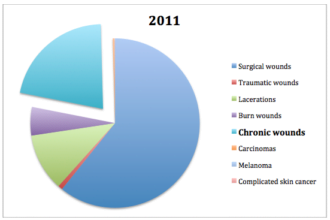New Kind of Engagement
Your doctors want you engaged. Your insurance company wants you engaged. The wellness crew at work wants you engaged. (Your mother may want you engaged, but it’s not that kind of engagement.) No diamonds. No champagne. All the health care liveware wants you engaged in managing your body. They particularly want you engaged in using the patient “portals” on their websites. Why so keen?
They make money that way.
New Kind of Engagement
Your doctors want you engaged. Your insurance company wants you engaged. The wellness crew at work wants you engaged. (Your mother may want you engaged, but it’s not that kind of engagement.) No diamonds. No champagne. All the health care liveware wants you engaged in managing your body. They particularly want you engaged in using the patient “portals” on their websites. Why so keen?
They make money that way.
The Blockbuster Drug
The “patient engagement” idea has drifted through the wonkosphere for a decade or so. The meaning is nebulous and is often confused with consumerism. A simple definition comes from the (now defunct) Center for Advancing Health: “Actions people take to support their health and benefit from their health care.”
Others describe patient engagement more zealously. Susan Dentzer called it the “blockbuster drug of the century” in Health Affairs. She was echoing Leonard Kish’s comment in his blog “The Blockbuster Drug of the Century: An Engaged Patient” from HL7 Standards.
No doubt, patients do best when they learn about care for their chronic diseases. People with diabetes, heart failure, multiple sclerosis or a host of disabling conditions need help. Nothing new there. I learned “patient teaching”, patient engagement’s precursor, as a principle of nursing. And I was a nursing student shortly after Florence Nightingale snuffed out her lamp.
Forty years ago patient teaching was lowly “nurse stuff”. Even ten years ago, the topic made eyes glaze over. Docs couldn’t be bothered. What changed? Money. As usual. Thirty-four billion dollars, give or take a million.
Portal To Your Life
The Health Information Technology for Economic and Clinical Health Act (HITECH) was passed in 2009 as part of American Recovery and Reinvestment Act (ARRA). The ARRA invested in everything from sewerage treatment plants to “No Child Left Behind” school funding. So far, $813 billion has been showered across the country, Texas, California and New York soaking up the most.
HITECH’s thirty-four billion bucks is a respectable 4% chunk of the bounty.
HITECH has a lofty goal:
The HITECH Act is intended to promote the widespread adoption of health information technology (HIT) to support the electronic sharing of clinical data among hospitals, physicians, and other health care stakeholders. HIT is widely viewed as a necessary and vital component of health care reform.
The Act is studded with financial rewards for hospitals and doctors. (None for you, the patient.) These incentives were designed to make adoption of electronic health records (EHRs) more enticing. For those not seduced, rewards mutate to penalties.
The feds realized thirty-four billion dollars sloshing around created a free-for-all for unscrupulous software hucksters. So the “Meaningful Use” was born, specifying required elements in EHRs. Meaningful Use rules include:
- Improve the quality, safety, and efficiency of care while reducing disparities;
- Engage patients and families in their care (emphasis mine);
- Promote public and population health;
- Improve care coordination;
- Promote the privacy and security of patient information.
Somewhere, some bureaucrats decided patient portals were proof people engaged with doctors and hospitals. The bureaucrats made rules about this too: “Provide patients the ability to view online, download and transmit their health information within four business days of the information being available to the EP.” (An “EP” is government-speak for “eligible professional” Also known as doctors.)
EHR peddlers rushed to embed patient portals in their software. Providers snapped them up, hoping to snag incentive money. And avoid fines.
Patients? Meh.
Triple Aim
Two years earlier, in 2007, an obscure think tank hatched a plan to restructure health care worldwide. The Institute for Healthcare Improvement dreamed up the “Triple Aim” framework. This scheme claims to give patients a better experience of care (not better care), make populations healthier and spend less on everybody’s care. (See my post on population health.)
Triple Aim translated? Give skimpy care as cheaply as possible as long as folks aren’t keeling over in droves. No wonder more American women are dying in childbirth.
Athenahealth sells EHRs, billing software and other medical practice services, all cloud-based. They own Epocrates®, the hugely popular mobile reference app for clinicians. Athenahealth likes the Triple Aim and patient engagement so much, the company wrote a white paper to prove it. According to Athenahealth:
Patient engagement has always been considered a good thing in practices and health care organizations. Today it is vital to the business of delivering care. Why the shift? Patient engagement is an essential strategy for achieving the “triple aim” of health care.
People shouting the loudest for patient engagement and the Triple Aim are those who stand to profit the most. The Healthcare Information and Management Systems Society (HIMSS) is an outfit dedicated to “Better health through information technology”. Self-described as a nonprofit, it’s a 501(c)(6) organization that lobbies and serves as a front for EHR vendors through a trade group called HIMSS Electronic Health Record Association (EHRA).
The president and CEO of this incestuous sprawl is H. Stephen Lieber, a founder of yet another HIMSS-related venture. The Certification Commission for Health Information Technology (CCHIT) was shuttered in 2014. In its ten-year run it certified the EHRs sold by EHRA’s vendors. Mr. Lieber collected a million and change in 2012 for his services. Presumably for his skill at skirting conflicts of interest.
HIMSS/EHRA affiliated companies such as Epic, Cerner and Allscripts have billions of dollars of vested interest in guaranteeing hospitals and doctors spend lots of money on their software.
Money they won’t have to spend for better care for you and your family.
Broken Engagement
The dubious Triple Aim framework justifies scanty, crowd-based care. Investors in electronic health record companies demand profits. The feds must defend the HITECH policy that poured billions down the gullets of insatiable EHR merchants. Providers need the promised incentives to recoup their tech costs. And insurance companies keep squeezing their policyholders to boost revenue.
Hospitals want to recruit patient and family “advisors” to “partner” with them: “Achieving theTriple Aim—better care, better health and lower cost—requires engaging patients and families in their own care as well as in organizational improvement initiatives.” No mention of pay.
All are convinced patient engagement is the answer. All are convinced patient portals are the fix. They’re so eager for profits, premiums and Meaningful Use money they ignored one thing.
The year is still young but it’s been labeled “The Year of the Health Care Hack” by the Washington Post. Andrea Peterson’s WP blog “The Switch” wrote that protected health care information for 120 million Americans has been hacked since 2009. More than a third of us. Peterson notes her numbers don’t include the 11 million folks whose data was snaffled from Premera Blue Cross near Seattle.
Premera’s website says, “The security of our members’ personal information is a top priority.”
Obviously not. They were warned. The FBI alerted health care providers more than a year ago their cybersecurity left much to be desired. The industry was cautioned their systems were vulnerable to all manner of hacking, malicious attacks and identity thefts. Health care information is a valuable commodity, selling on the black market for much more than simple credit card data.
Pro Publica is “…an independent, non-profit newsroom that produces investigative journalism in the public interest.” Their website has interactive graphs that show state-by-state health care data breaches. Worth a look.
Doctors, hospitals, insurance companies and EHR outfits ignored the warnings. For years. Too busy worrying about the money to be made. Couldn’t be bothered safeguarding their systems.
Could not be engaged enough to care about your security.
Now they want you engaged. They want you to use their portals. Upload intimate information. Your symptoms, your drugs, your emotional problems. Make appointments. Pay bills. View sensitive biopsy results. On computer systems that may be less secure than Home Depot’s.
Why should you? The Triple Aim is Triple Trouble for you. Less care, less personal attention and your most confidential information waiting to be hacked. Tell health care types who want you engaged you’re not interested in their patient portals. You’re holding out for diamonds.
(Two tips: Never let any health care provider photocopy your driver’s license or use the number for identification. Tell them they may view it each time you’re seen, but may not make a record of it. And do not put your Social Security Number on any medical documents or patient info sheets.)







_9_2-250x220.jpg)

